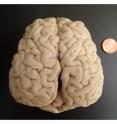Scientists establish first map of the sea lion brain
Rio is a California sea lion who can solve IQ tests that many people have trouble passing. In fact, she is so smart that scientists at the Long Marine Lab at the University of California, Santa Cruz designed a series of tests that prove she is the first animal besides humans that can use basic logic (If A=B and B=C then A=C). Rio's display of intelligence is less surprising when you consider the fact that she is a member of one of only four groups of animals that have evolved extremely large brains (weighing more than 1.5 pounds). Along with seals and walruses, she is part of a group of fin-footed, semiaquatic marine mammals called pinnipeds. The other large-brained groups are humans, elephants and cetaceans (whales and dolphins).
Despite considerable evidence of their cerebral skills, very little is known about pinniped brains. However, a team of neuroscientists at Vanderbilt University has taken an important step toward rectifying this lack of knowledge by conducting the first comprehensive study of the California sea lion's central nervous system, concentrating on the somatosensory system, which is concerned with conscious perception of touch, pressure, pain, temperature, position and vibration.
Last year, the dramatic upsurge of juvenile California sea lion deaths due to strandings throughout central and southern California made it possible for Sawyer to obtain two juvenile sea lion brains for study. (Sea lions, like all marine mammals, are protected by the federal government under the Marine Mammal Protection Act of 1972.)
The results of their study are described in the paper "Somatosensory brain stem, thalamus and cortex of the California sea lion (Zalophus californianus)" published online in the early view of the Journal of Comparative Neurology.
"It was amazing to see the sea lion brain for the first time because, after spending years studying brains, it was shocking to see something so large and so different from any other brain I had ever worked with," said first author Eva Sawyer, a doctoral student in neuroscience at Vanderbilt. Fellow doctoral student Emily Turner collaborated in the study under the supervision of Jon Kaas, Gertrude Conaway Vanderbilt Professor in Social and Natural Sciences.
"We know a lot about how some brains are organized and function, mice and primate brains for example, but mammals are highly varied, and we know almost nothing about the brains of most mammals, including pinnipeds," said Kaas.
Humans, elephants, cetaceans and pinnipeds each evolved large brains independently, so the way that their brains are organized is quite different, particularly the cortex. Due to our inherent interest in our own evolution and the importance of the large human brain to our identity, it is worthwhile looking at these independent examples of how brains become large, Sawyer pointed out.
Sea lion brains are about the same size as chimpanzee brains. Although they have some features in common with the brains of their closest relatives - dogs, cats, bears and weasels - their brains are also intensely folded in a fashion similar to that of whales and dolphins.
"It is striking that both cetaceans and pinnipeds tend to have large and convoluted brains, but there is no single accepted explanation for this observation," said Sawyer. "It is at least partially explained by their large body size. Animals with larger bodies are expected to have larger brains. But it may also be related to other factors, such as the weightlessness of the marine environment or coping with cold water temperatures. Or it could just be a random outcome of evolution."
The researchers focused on the sea lion's somatosensory system because they were particularly curious about the animal's sense of touch. "We have long wondered about how the somatosensory systems of sea lions and seals are organized, as they have such remarkable abilities to use touch and their whiskers to explore and feed in deep water," Kaas said.
Using modern histochemical methods, Sawyer and Turner were able to identify and characterize the major parts of the sea lion brain that are used in processing touch information from the whiskers and the skin. These include areas in the brainstem, thalamus and cortex.
They discovered that the marine mammal's brain has specific areas for processing information from its whiskers that are strikingly similar to those found in mice and rats, who are considered the whisker specialists in the animal kingdom. Specifically, they found that each whisker on the sea lion's nose has a specific, corresponding area in the brainstem devoted to it. These are comparable to specific areas on the human brain that correspond to individual fingers. Their existence confirms that these "mystacial " whiskers play an important role in sea lion sensation and behavior.
In addition, the researchers identified the brain areas devoted to processing touch sensations from the sea lion's flippers and tail. One of the surprises was discovery of a well-developed region, called Bischoff's nucleus, which is found in animals with prominent tails ranging from raccoons to kangaroos to whales. It is surprising because the sea lion's tail is not prominent at all: It is small and tucked between its hind flippers.
Once mapping of the sea lion's somatosensory region is complete, the researchers plan on mapping the parts of its brain devoted to other functions. "It will be interesting to compare its overall structure to that of primate brains," Sawyer said.
The researchers would also like to map the brains of other pinnipeds, like walrus and elephant seals, which have much larger brains.
Source: Vanderbilt University
Other sources
- Scientists establish first map of the sea lion brainfrom Science DailyThu, 28 Apr 2016, 0:40:43 UTC
- Scientists establish first map of the sea lion brainfrom PhysorgWed, 27 Apr 2016, 21:50:44 UTC
- Scientists Establish First Map of the Sea Lion Brainfrom Newswise - ScinewsWed, 27 Apr 2016, 21:20:59 UTC
